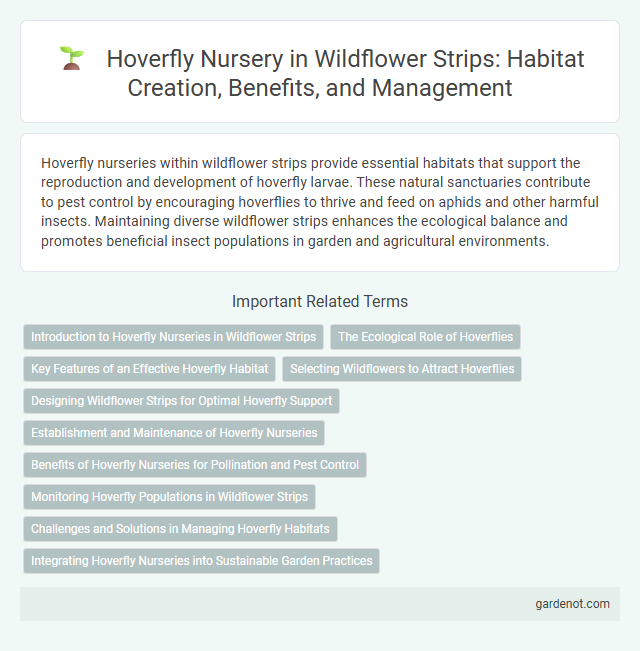Hoverfly nurseries within wildflower strips provide essential habitats that support the reproduction and development of hoverfly larvae. These natural sanctuaries contribute to pest control by encouraging hoverflies to thrive and feed on aphids and other harmful insects. Maintaining diverse wildflower strips enhances the ecological balance and promotes beneficial insect populations in garden and agricultural environments.
Introduction to Hoverfly Nurseries in Wildflower Strips
Hoverfly nurseries within wildflower strips provide essential habitats that support the reproduction and development of syrphid flies, which are crucial pollinators and natural pest controllers. These nurseries consist of diverse native plants offering nectar, pollen, and shelter, creating an ideal environment for hoverflies to thrive throughout their life cycle. Implementing hoverfly nurseries enhances biodiversity, promotes sustainable agriculture, and improves ecosystem resilience by boosting beneficial insect populations.
The Ecological Role of Hoverflies
Hoverfly nurseries provide essential habitats that support the lifecycle of hoverflies, which play a critical ecological role as effective pollinators in wildflower strips. These insects contribute significantly to biodiversity by enhancing the reproduction of various wildflower species and naturally controlling aphid populations through their larvae. Establishing well-managed hoverfly nurseries within wildflower strips promotes ecosystem balance and sustains agricultural productivity by boosting pollination services.
Key Features of an Effective Hoverfly Habitat
An effective hoverfly habitat in a wildflower strip incorporates diverse native flowering plants that provide continuous nectar and pollen sources throughout the growing season. Structural elements such as sheltered areas and moist soil zones support hoverfly larval development and encourage population stability. Incorporating non-crop plants that attract aphids also ensures a reliable food supply for hoverfly larvae, enhancing natural pest control within the ecosystem.
Selecting Wildflowers to Attract Hoverflies
Selecting wildflowers such as yarrow, cosmos, and marigold creates an ideal habitat for hoverfly nurseries by attracting these beneficial insects with abundant nectar and pollen. Including early spring bloomers like forget-me-nots supports hoverfly larvae development by ensuring a steady food supply from aphids. Diverse wildflower strips with continuous blooming periods enhance hoverfly population growth and effective natural pest control in garden ecosystems.
Designing Wildflower Strips for Optimal Hoverfly Support
Designing wildflower strips to support hoverfly nurseries requires selecting a diverse mix of native flowering plants that bloom sequentially from early spring to late autumn, ensuring continuous nectar and pollen sources. Incorporating plants from the Apiaceae and Asteraceae families enhances habitat suitability, as these flowers provide essential resources for hoverfly larvae and adults. Strategic placement of wildflower strips near agricultural fields maximizes pollination benefits and natural pest control by encouraging hoverfly population growth and sustainability.
Establishment and Maintenance of Hoverfly Nurseries
Establishing hoverfly nurseries within wildflower strips involves selecting diverse native plant species that bloom sequentially to provide continuous nectar and pollen sources, essential for hoverfly adult nutrition and reproductive success. Regular maintenance includes periodic mowing outside peak flowering periods to prevent woody plant encroachment and ensure habitat quality, alongside monitoring hoverfly population dynamics to assess nursery effectiveness. Integrating hoverfly nurseries into wildflower strips enhances biological pest control by supporting hoverfly larvae predation on aphids and other crop pests.
Benefits of Hoverfly Nurseries for Pollination and Pest Control
Hoverfly nurseries in wildflower strips significantly enhance pollination efficiency by attracting diverse hoverfly species that contribute to the fertilization of crops and wild plants. These nurseries provide essential breeding habitats, supporting hoverfly populations that naturally suppress aphids and other harmful pests through predation. Implementing hoverfly nurseries promotes sustainable agriculture by reducing the need for chemical pesticides while boosting biodiversity and crop yields.
Monitoring Hoverfly Populations in Wildflower Strips
Monitoring hoverfly populations in wildflower strips involves regular sampling using methods such as sweep nets and pan traps to assess species diversity and abundance. Data collected on hoverfly activity helps evaluate the effectiveness of wildflower strips in providing habitat and supporting natural pest control through pollination. Understanding population trends allows for adaptive management practices that enhance hoverfly conservation and maximize ecological benefits.
Challenges and Solutions in Managing Hoverfly Habitats
Managing hoverfly habitats within wildflower strips faces challenges such as habitat fragmentation, pesticide exposure, and limited floral diversity, which reduce hoverfly populations and pollination efficiency. Implementing diverse native plant species with staggered bloom periods and minimizing pesticide use enhances habitat quality and supports sustained hoverfly activity. Strategic placement of wildflower strips adjacent to agricultural fields improves habitat connectivity, promoting robust hoverfly populations and ecosystem services.
Integrating Hoverfly Nurseries into Sustainable Garden Practices
Hoverfly nurseries play a vital role in sustainable garden practices by enhancing pollination and natural pest control within wildflower strips. Incorporating hoverfly habitats supports biodiversity, promoting the growth of native plants and reducing reliance on chemical pesticides. Strategic placement of these nurseries fosters a balanced ecosystem, encouraging beneficial insect populations to thrive in garden environments.
Hoverfly nursery Infographic

 gardenot.com
gardenot.com